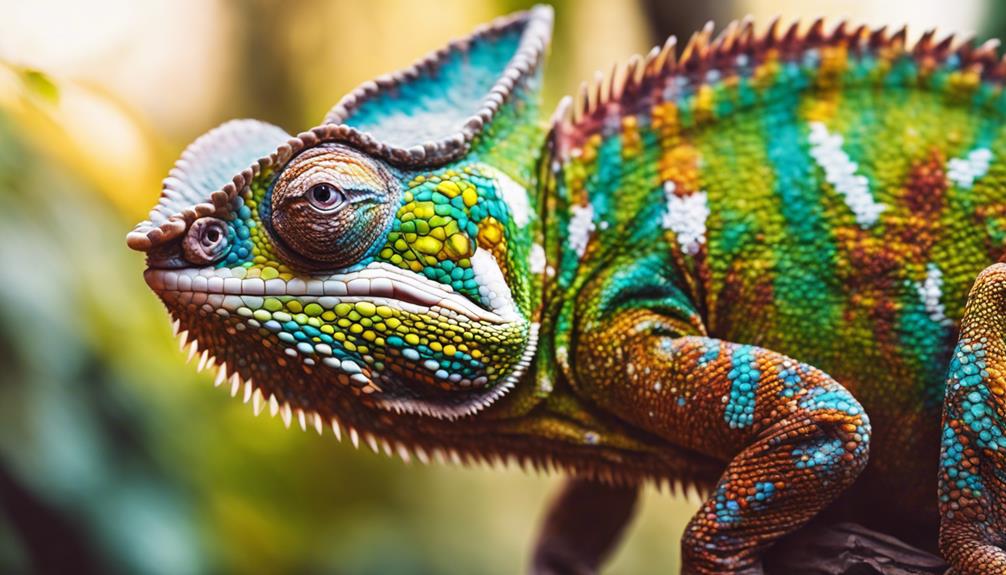Are you interested in exploring the intriguing world of chameleons? These unique reptiles possess some fascinating qualities that set them apart from other creatures.
From their mysterious color-changing abilities to their specialized tongues for hunting, chameleons have many to offer regarding natural marvels.
As we investigate deeper into the facts about these alluring creatures, you’ll uncover a wealth of information that will leave you amazed and wanting to discover more about these enigmatic reptiles.
Chameleon Characteristics
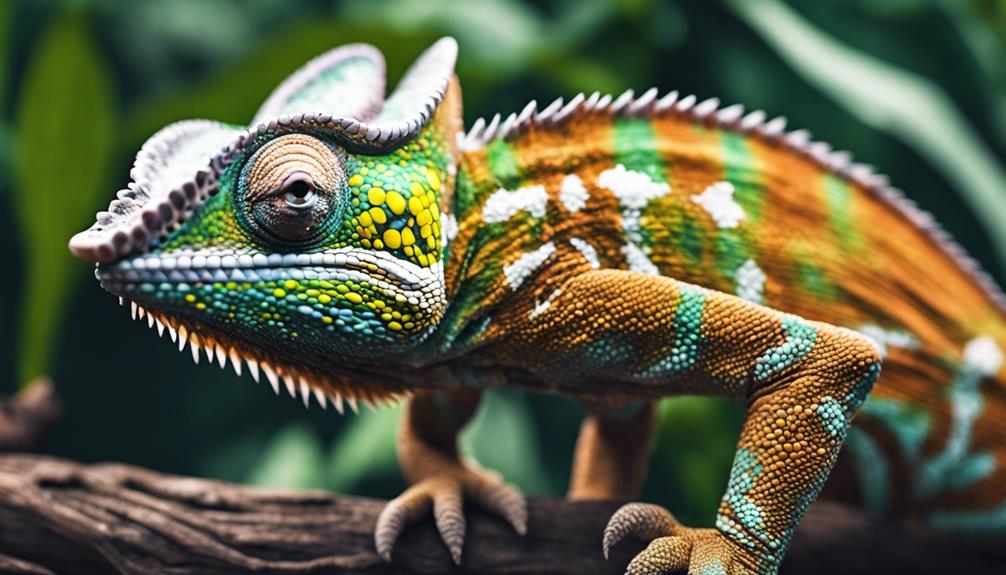
With their telescopic eyes, grasping tails, color-changing skin, and projectile tongue, chameleons showcase a remarkable array of unique characteristics that set them apart in the animal kingdom. These features are essential for their survival in diverse environments where they can be found, such as deserts, rainforests, and savannas.
Chameleons can rotate and focus each eye independently, allowing them to have a 360-degree field of vision. Their color-changing skin, controlled by specialized cells called chromatophores, helps them blend into their surroundings for camouflage and serves as a means of communication.
For hunting, chameleons use their projectile tongues to catch prey with incredible accuracy, shooting them out at high speeds to grasp insects from a distance. These unique traits make chameleons fascinating creatures to study and admire, showcasing the incredible diversity present among chameleon species.
Unique Chameleon Features
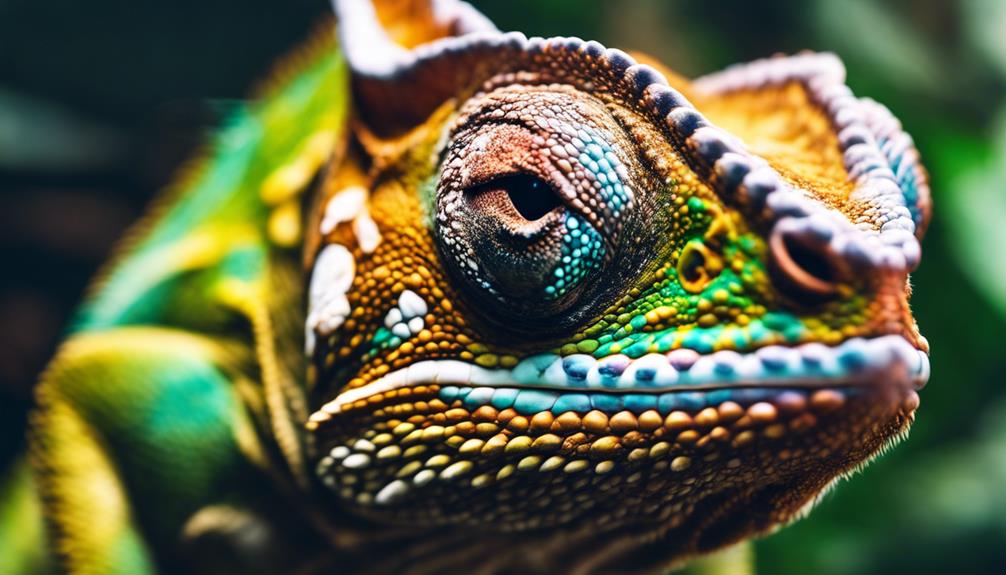
What makes chameleons stand out among other creatures in the animal kingdom?
Chameleons possess a unique set of features that make them truly remarkable. Their telescopic eyes have a 360-degree field of vision, enabling them to spot prey and predators with precision. Coupled with their grasping tails, chameleons exhibit exceptional climbing abilities, effortlessly maneuvering through their arboreal habitats.
One of the most iconic traits of chameleons is their color-changing skin, a feature that not only aids in camouflage but also serves as a means of communication, reflecting their mood, reproductive status, and dominance within their social structure. Additionally, chameleons are equipped with a projectile tongue that can extend up to twice the length of their body, enabling them to capture prey from a distance.
These unique characteristics, combined with their ability to inhabit diverse environments ranging from deserts to rainforests, contribute to the distinctive nature of chameleons. With over 200 species, including 76 endemic to Madagascar, chameleons showcase an extraordinary adaptation to their surroundings.
Chameleon Habitats
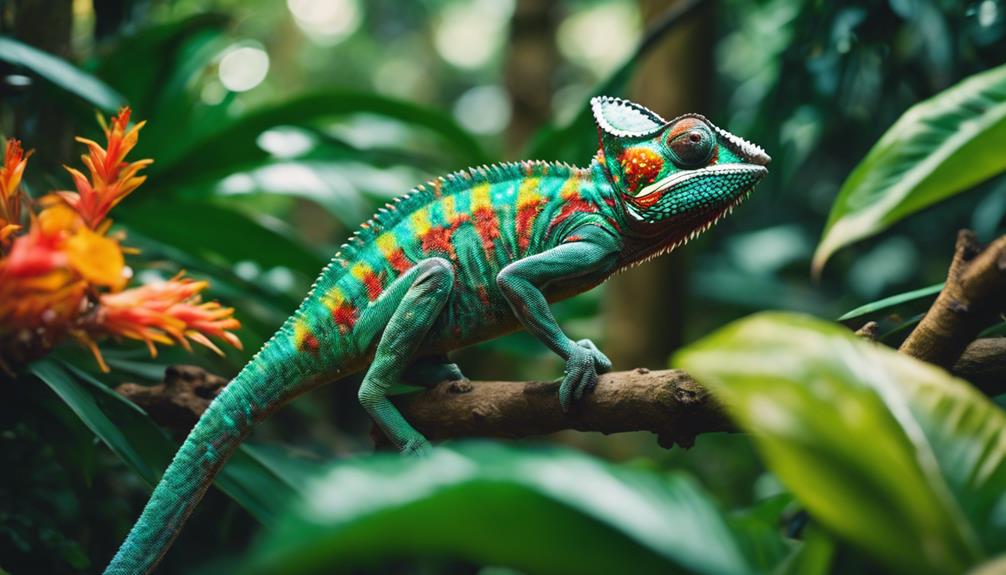
Chameleons inhabit a variety of environments, including African rainforests, deserts, and tropical regions, showcasing their remarkable adaptability to diverse habitats. The ability to change color is not merely a visual spectacle but a survival strategy essential for blending in with their surroundings, offering them camouflage and protection. Green chameleons, often residing in lush rainforests, use their color-changing skill to blend seamlessly with the vibrant foliage, while brown chameleons, commonly found in arid deserts, adapt their skin tones to match the sandy terrain. These reptiles are native to sub-Saharan Africa and Madagascar, thriving in the warm, tropical climates of these regions.
| Habitat | Characteristics | Examples |
|---|---|---|
| African Rainforests | Lush vegetation, vibrant colors, high humidity | Veiled Chameleon, Panther Chameleon |
| Deserts | Arid landscapes, sandy terrain, sparse vegetation | Namaqua Chameleon, Meller’s Chameleon |
| Tropical Regions | Dense forests, diverse wildlife, warm climate | Jackson’s Chameleon, Parson’s Chameleon |
However, chameleons face a pressing threat due to habitat loss, endangering their populations in the wild. It is essential to address conservation efforts to safeguard these remarkable creatures and the ecosystems they inhabit.
Chameleon Diet
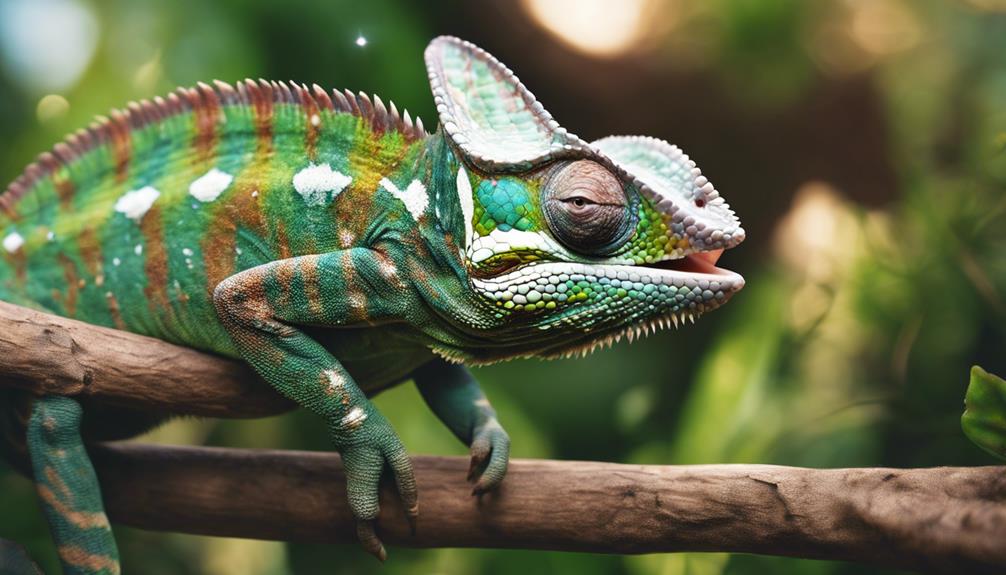
In various habitats ranging from African rainforests to deserts, chameleons exhibit specific dietary preferences and feeding behaviors that are essential for their survival. Chameleons are primarily insectivores, with a diet consisting of insects such as locusts, mantids, grasshoppers, and crickets. While some chameleon species may also consume plants, small rodents, or birds for additional nutrients, their main source of food remains live prey. Using their long, sticky tongues with rapid precision, chameleons catch insects to meet their dietary needs. Their small, triangular, and spiky teeth aid in gripping and consuming their prey effectively.
Additionally, chameleons rely on water droplets found on leaves as a source of hydration. They lap up water using their tongues, ensuring they stay hydrated in their habitats. This unique method of obtaining water complements their insectivorous diet, providing them with the necessary nutrients and hydration for their overall well-being.
Chameleon Adaptations

Adapted to their varied habitats, chameleons possess remarkable physical features that enable them to thrive in diverse environments. These adaptations include:
- Specialized Feet and Prehensile Tails: Chameleons have unique feet with fused toes that are divided into two groups, enabling them to grasp branches tightly. Their prehensile tails further aid in climbing trees and maintaining balance while maneuvering their arboreal habitats.
- Color-Changing Skin: The chameleons’ ability to change color isn’t just for camouflage; it also helps them communicate with other chameleons, regulate their body temperature, and attract potential mates. This remarkable feature allows them to blend seamlessly into their surroundings while conveying their emotions and intentions.
- Excellent Eyesight: Chameleons possess exceptional eyesight, with each eye moving independently to provide a 360-degree field of vision. This keen eyesight aids in hunting for prey and detecting potential predators, ensuring their survival in the wild.
- Adaptive Behavior: Chameleons exhibit a range of behaviors that complement their physical adaptations, such as their quick reflexes in catching prey with their powerful tongues and the display of horns and spikes by males for territorial defense and asserting dominance in their social hierarchy.
Chameleon Species Diversity
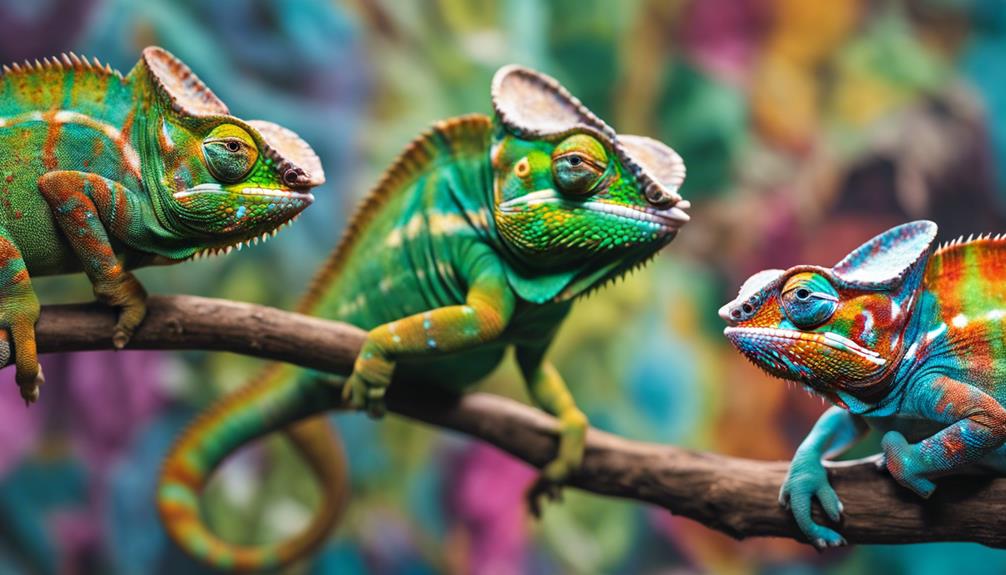
With over 200 species worldwide, the diversity of chameleons, especially those endemic to Madagascar, showcases a remarkable array of unique characteristics and adaptations. Madagascar, hosting 76 chameleon species, plays a significant role in chameleon species diversity. This island alone is home to two-thirds of all chameleon species, demonstrating high levels of endemism. Since 1997, approximately 44 new chameleon species have been described, indicating ongoing discoveries and research in this field.
To organize this diverse group, a taxonomic checklist was published in 2015, aiding in the classification and understanding of chameleon species. These reptiles vary greatly in size, ranging from the tiny Brookesia micra, measuring about 1.1 inches, to the large Parsons chameleon, which can grow over 2 feet long. The sheer diversity of chameleon species, their unique adaptations, and the ongoing discoveries in this field make them a fascinating subject of study.
Madagascar’s Chameleon Endemics
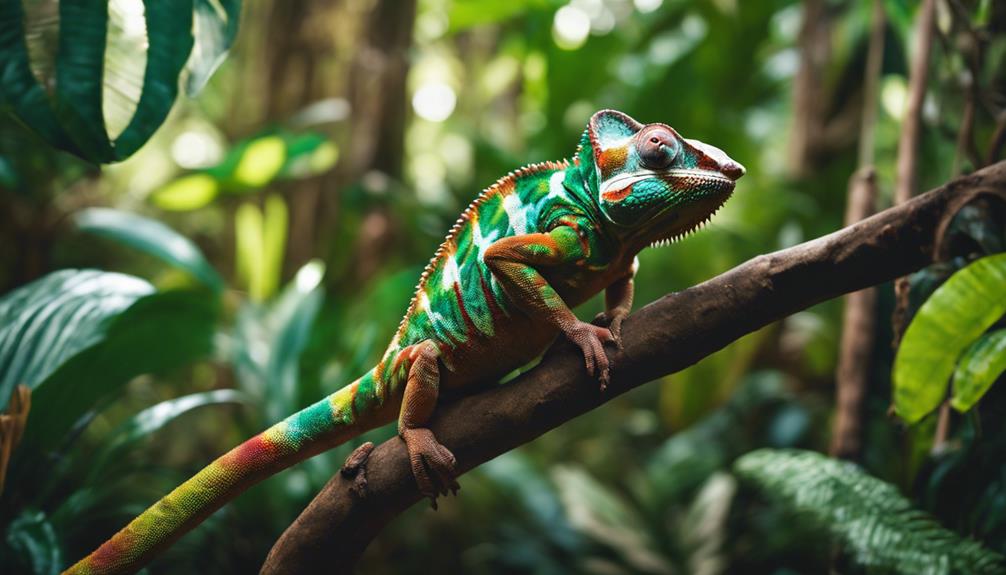
Madagascar’s unique chameleon endemics boast an impressive array of adaptations and behaviors exclusive to the island’s diverse habitats. These endemic chameleons have evolved unique features to thrive in Madagascar’s varied ecosystems.
- Endemic Species: Madagascar is home to 76 chameleon species that are found only on the island, showcasing the extraordinary biodiversity present in this region.
- Adaptations: The chameleon species endemic to Madagascar exhibit a wide range of sizes, colors, and behaviors, reflecting the specialized evolution that has taken place in response to the island’s distinct environments.
- Critical Efforts: Conservation efforts are critical to safeguard these endemic chameleon species from threats such as habitat loss, climate change, and human activities that endanger their survival.
- Biodiversity Importance: The high level of endemism among Madagascar’s chameleons underscores the significance of the island for biodiversity conservation, highlighting the need to protect these unique and irreplaceable species.
Chameleon Hunting Techniques

Chameleon hunting techniques showcase their remarkable ability to employ stealth and precision in capturing prey using a combination of exceptional eyesight and lightning-fast tongue movements. These reptiles rely on their keen eyesight to spot prey from a distance, allowing them to carefully approach their target without alerting it. When the moment is right, chameleons release their long, muscular tongues that can extend up to twice the length of their bodies, trapping insects in a fraction of a second.
Their hunting technique involves a strategic approach, where they position themselves close to unsuspecting prey before launching their tongues with incredible speed and accuracy. The specialized design of their tongues, coupled with their quick reflexes, guarantees a high success rate in capturing insects. Chameleons use their specialized feet and tails to navigate branches silently, positioning themselves for the perfect ambush.
In the chameleon world, hunting is a finely tuned skill that combines sensory perception, physical agility, and lightning-quick strikes to secure their next meal.
Chameleon Climbing Abilities
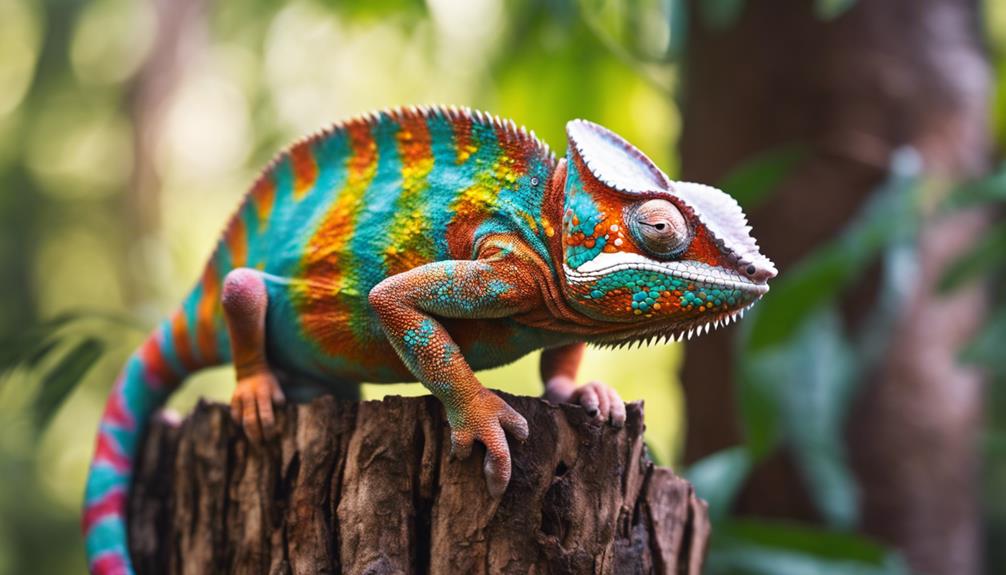
Chameleons showcase impressive climbing abilities with their specialized feet and prehensile tails facilitating effortless navigation in arboreal environments. Their unique adaptations make them skilled climbers, allowing them to move with agility and precision among tree branches.
- Specialized Feet: Chameleons have specialized feet with fused toes that function like fingers and thumbs, enabling them to grip branches securely while climbing.
- Vital Tails: Their prehensile tails play a vital role in climbing by providing additional stability and mobility. These tails wrap around branches, aiding in balance and navigation.
- Tail Importance: Unlike many other lizards, chameleons can’t regenerate lost tails. This makes their tail an essential tool for climbing and movement in their arboreal habitats.
- Species Variations: Some chameleon species, such as Jackson’s chameleons, have specific physical features that enhance their climbing abilities, allowing them to navigate challenging terrains effectively.
Chameleon Color Change
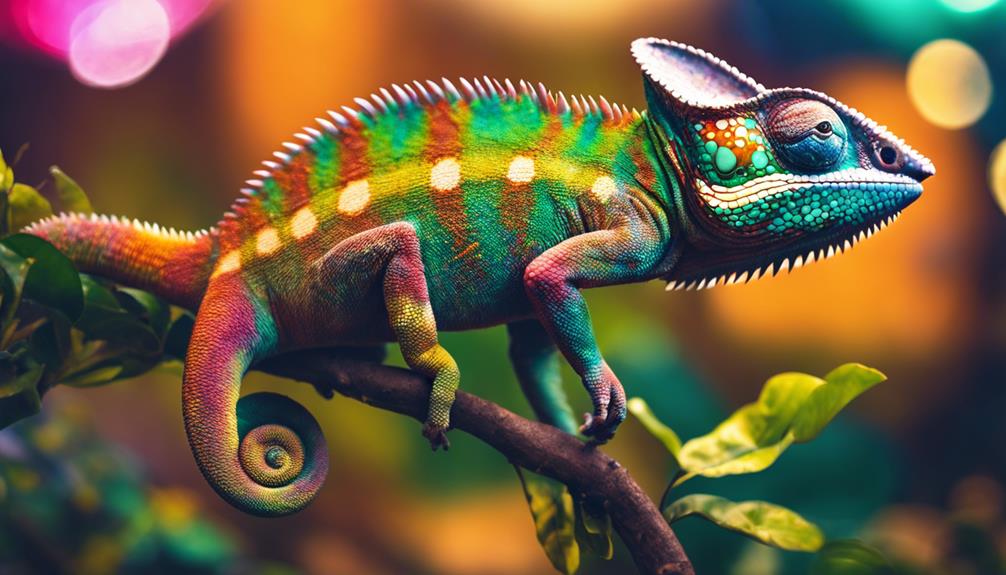
With their skin comprising specialized cells that reflect and absorb light, chameleons exhibit a remarkable ability to change color based on various environmental factors such as mood, temperature, light, and humidity. These color changes aren’t just for aesthetics but also play a significant role in communication and temperature regulation. Chameleons utilize their unique color-changing ability to blend into their surroundings, signal their mood, and adjust their body temperature effectively.
The special cells responsible for this phenomenon are called iridophores and are present in their skin. These iridophores reflect and absorb light, allowing chameleons to alter their colors rapidly. Different colors displayed by chameleons can signify various messages such as gender, dominance, social interactions, courtship, and aggression. For instance, male chameleons may change colors during courtship displays to attract mates or during aggressive encounters to establish dominance within their community.
In essence, the ability of chameleons to change colors serves as a multifunctional tool aiding in their survival, communication, and overall adaptation to their environments.
Chameleon Communication
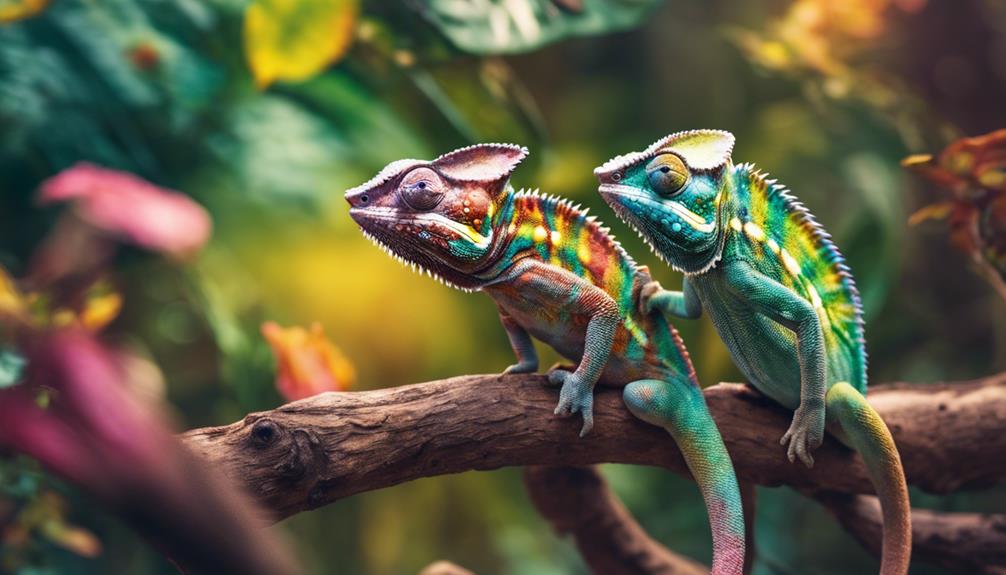
Utilizing their intricate color-changing ability, chameleons engage in a sophisticated form of visual communication within their species. This communication is vital for their social interactions and plays a significant role in their behavioral displays. Here are some key points about chameleon communication:
- Displaying Vibrant Hues: Chameleons change color to communicate various messages, including attracting mates or signaling aggression. The vibrant hues they exhibit serve as visual cues for other chameleons, conveying important information.
- Reflecting Mood and Reproductive Status: The color changes in chameleons not only reflect their mood but also indicate their reproductive status. These color variations help in conveying their current state to other members of their species.
- Signaling Dominance: Males often exhibit bright head colors and perform quick color changes to indicate dominance and attract females. This signaling through color plays a vital role in establishing hierarchy within chameleon communities.
- Form of Visual Communication: Chameleons rely heavily on their color-changing ability as a form of visual communication. This method allows them to convey a wide range of messages without the need for vocalizations, making it an essential aspect of their social interactions.
Chameleon Eye Structure

Having explored the intricate world of chameleon communication, we now turn our attention to the remarkable structure of their eyes, a key component of their sensory prowess in traversing their surroundings. Chameleons possess eyes that can move independently, granting them a panoramic view of their environment.
These unique eyes enable them to rotate 180 degrees and see a full 360 degrees around them, enhancing their ability to detect both threats and prey efficiently. By moving their eyes separately, chameleons can focus on different objects simultaneously, aiding in their hunting endeavors and overall survival in their arboreal habitats.
Despite their exceptional daytime vision, chameleons have limited capabilities to see in the dark, relying primarily on their diurnal activities. This specialized eye structure not only assists in hunting but also plays a pivotal role in their navigation through the intricate ecosystems they inhabit, showcasing the adaptability and evolutionary marvel of these intriguing reptiles.
Chameleon Reproduction
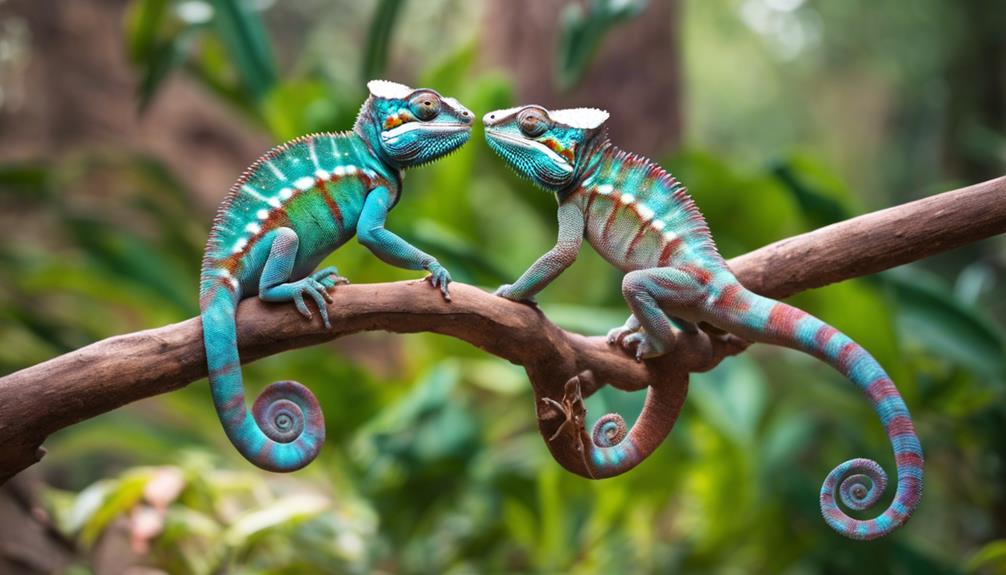
Chameleons reproduce through a variety of methods, including laying eggs or giving birth to live young, depending on the species.
- Eggs: Most chameleon species lay eggs, with clutch sizes ranging from 2 to 40 eggs.
- Clutch Sizes: The number of eggs in a clutch can vary notably among different chameleon species, influencing the potential offspring numbers.
- Incubation Period: The incubation period for chameleon eggs can vary widely, lasting anywhere from 4 to 24 months, depending on the species. This important incubation time is necessary for the development of the embryos inside the eggs.
- Live Young: In contrast, some chameleon species, such as Jackson’s chameleons, give birth to live young instead of laying eggs. The offspring are born independent and don’t require extensive parental care for survival, showcasing the diverse reproductive strategies within the chameleon family.
Chameleon Lifespan
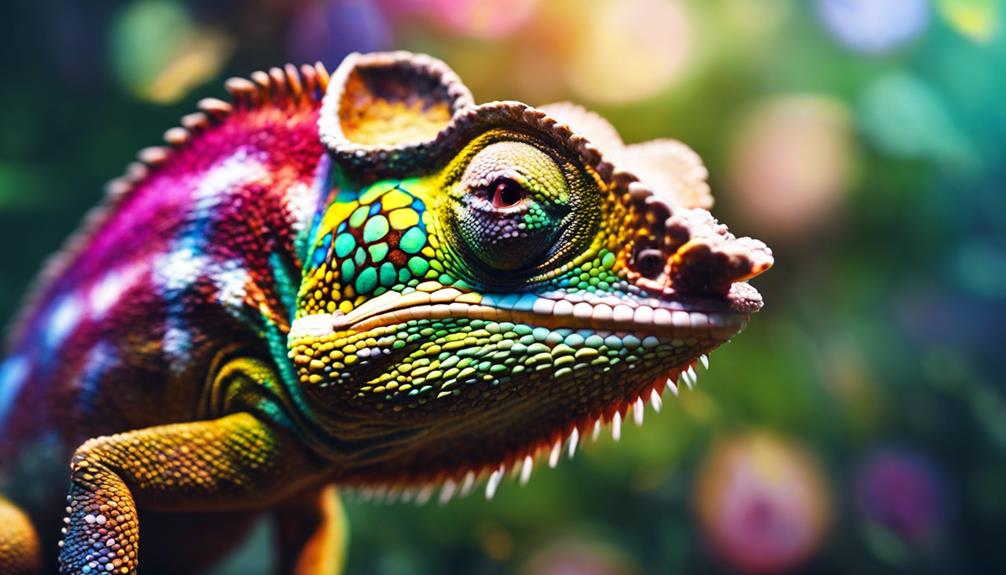
Chameleon reproduction strategies, such as laying eggs or giving birth to live young, are closely linked to the fascinating topic of chameleon lifespan. Chameleons typically live for 3 to 5 years in the wild, with some species like the Veiled Chameleon reaching 5 to 8 years in captivity. Factors such as habitat, diet, and stress levels play important roles in determining a chameleon’s lifespan.
The Jackson’s Chameleon, for instance, has a lifespan of around 5 to 10 years, while Panther Chameleons have been observed to live up to 5 to 7 years.
Chameleons living in their natural habitats, with access to a varied diet and minimal stress, tend to exhibit longer lifespans. The stress levels induced by factors like environmental changes, captivity conditions, and inadequate nutrition can significantly impact their longevity.
Understanding and providing for the specific needs of chameleons regarding habitat, diet, and stress management is essential for ensuring their well-being and potentially extending their lifespan.
Chameleon Tongue Mechanics
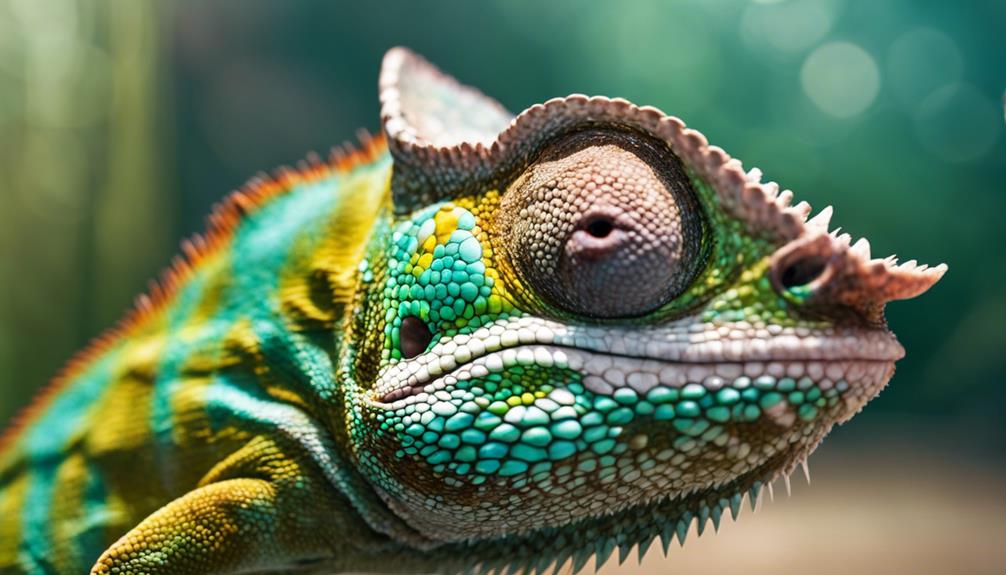
Equipped with tongues that extend twice the length of their bodies, chameleons possess remarkable mechanisms for swiftly capturing prey. This unique feature allows them to catch insects with impressive accuracy and speed.
- Specialized Muscles and Bones: Chameleon tongues aren’t just long but also have specialized muscles and bones that enable rapid extension and retraction. These structures provide the necessary force for the tongue to shoot out and grab prey efficiently.
- Sticky Mucus: To enhance their prey capture capabilities, chameleon tongues are equipped with sticky mucus. This adhesive substance helps in securing the prey once it’s caught, preventing it from escaping.
- Rapid Extension and Retraction: Chameleons use the rapid extension and retraction of their tongues to capture insects in a fraction of a second. This swift movement is vital for successful hunting and guarantees that the prey is caught before it can react.
- Precision and Speed: By projecting their powerful tongues outward, chameleons can capture prey with precision and speed, showcasing their remarkable hunting prowess.
Chameleon Camouflage Misconceptions

Incorporating an intricate blend of color adaptation and signaling mechanisms, chameleons’ camouflage abilities often misconstrue their primary purpose. Contrary to popular belief, chameleons don’t change color to match their camouflage background. Instead, their color-changing ability is a sophisticated communication tool that reflects various internal and external factors.
While they can adjust their hues to blend in somewhat with their surroundings, chameleons mainly use color transformations to convey their emotions, intentions, and social status.
These reptiles alter their skin color based on mood, temperature, and interactions with other chameleons. Bright displays aren’t solely for hiding but are also utilized to attract potential mates or to signal aggression. The misconception that chameleons mostly rely on color change for camouflage overlooks the rich complexity of their signaling behaviors.
Understanding the intricate nature of chameleons’ color adaptation processes can provide valuable insights into their social dynamics and overall well-being.
Chameleon Threats and Conservation

Amidst the pressing concerns facing chameleons today, numerous species are grappling with endangerment due to various human-induced threats. These threats include habitat loss, illegal collection for the pet trade, climate change, and other human activities. Conservation efforts are essential to protect chameleons and guarantee their survival. Specific chameleon species, such as the critically endangered Parson’s chameleon in Madagascar, require urgent conservation action.
Here are some key points to ponder regarding chameleon threats and conservation:
- Endangered because of habitat: Chameleons face habitat destruction and fragmentation, impacting their ability to find food, breed, and seek shelter.
- Illegal collection: The pet trade poses a significant threat to chameleons, leading to population declines and disrupting ecosystems.
- Conservation efforts: Focus on safeguarding chameleon habitats, raising awareness about their plight, and enforcing regulations to combat illegal trade.
- Specific chameleon species: The Parson’s chameleon exemplifies the critical need for targeted conservation measures to prevent its extinction.
Frequently Asked Questions
What Are 3 Interesting Facts About Chameleons?
Chameleons amaze with their color-changing skin for mood and communication. Their telescopic eyes provide 360-degree vision insight. Diverse habitats from deserts to rainforests house over 200 species, each with unique features like grasping tails and projectile tongues.
What Is Special About the Chameleon?
Chameleons possess extraordinary adaptations like telescopic eyes, color-changing skin, and projectile tongues. Their specialized features aid in survival, communication, and hunting. These reptiles, with over 200 species, are marvels of evolution, perfectly suited to diverse habitats.
How Many Hearts Do Chameleons Have?
You might be surprised, but chameleons have only one heart. Their heart, with two atria and one ventricle, efficiently pumps oxygenated blood to the body and deoxygenated blood to the lungs, supporting their remarkable abilities.
Do Chameleons Have Teeth?
Yes, chameleons have teeth. Their small, triangular teeth are used for gripping and crushing prey, not for chewing. They primarily rely on their powerful tongues for catching and consuming insects. The teeth are specialized for their carnivorous diet.
Conclusion
To sum up, the enchanting world of chameleons offers a plethora of fascinating facts to explore. These remarkable creatures possess unique characteristics and adaptations that make them truly extraordinary. Their diverse habitats, specialized diet, and intricate tongue mechanics contribute to their survival in the wild.
While facing threats to their existence, chameleons continue to adapt and thrive in their ever-changing environments. Embrace the wonder of these incredible reptiles and appreciate the complexity of their existence.
